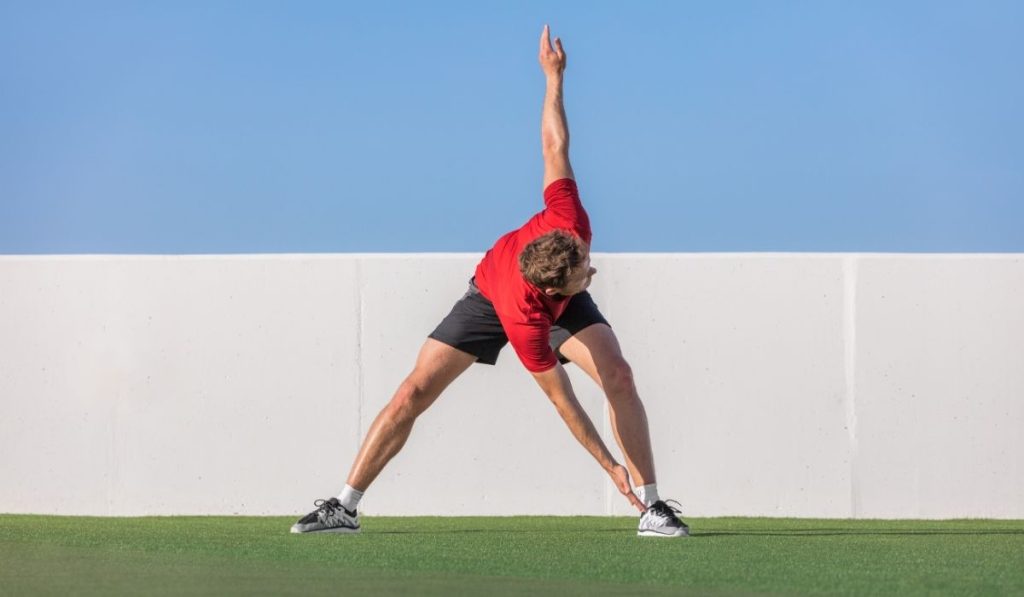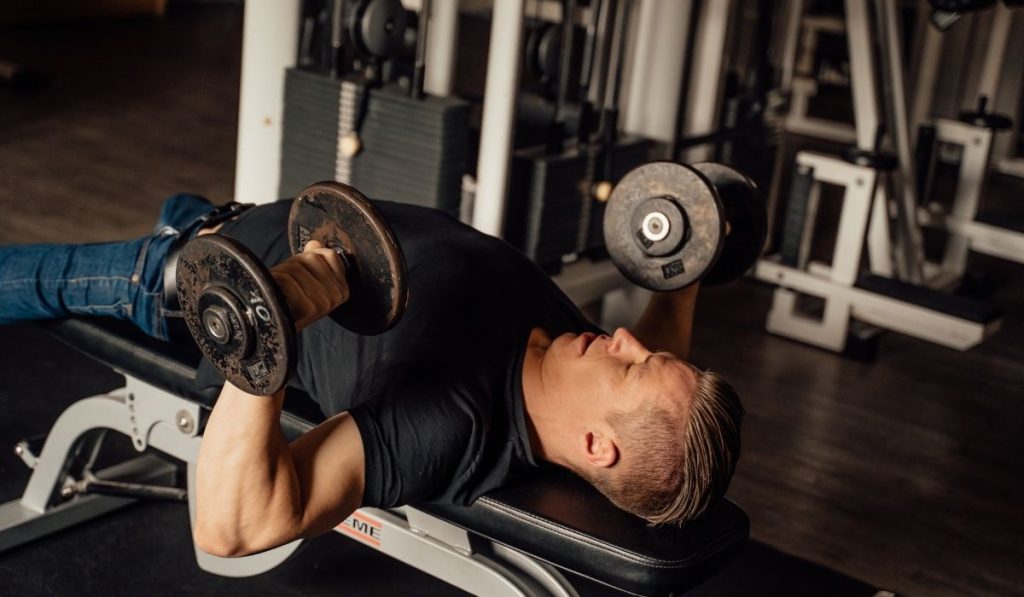Are you someone who hits the gym regularly or engages in weightlifting exercises? If yes, then you must be aware of how important it is to warm up before beginning any workout routine. Warming up is essential to prepare your body for the workout and avoid any injuries. And when it comes to working out your chest muscles, it’s even more crucial to do a proper warm-up.
In this blog post, we will be discussing some effective chest warm up exercises that can help you get ready for your workout. Whether you are a beginner or an advanced gym-goer, these exercises are suitable for everyone. We’ll be covering everything from the benefits of chest warm up exercises to the different types of exercises you can perform.
By incorporating these chest warm up exercises into your routine, you’ll not only be reducing the risk of injury but also improving your overall performance. So, let’s dive in and learn more about the importance of chest warm up exercises and how you can get started on your fitness journey today.
Importance of Warming Up Before Workouts
Warming up before workouts is essential for preparing the body for physical activity. It involves performing light exercises and stretching to increase blood flow to the muscles, increase body temperature, and improve joint mobility. Warming up has several benefits, including:
- Reduced Risk of Injury: Proper warm-up routines can reduce the risk of injury by increasing the flexibility and elasticity of the muscles and connective tissues. This helps to prevent muscle strains, sprains, and other injuries that can occur during exercise.
- Improved Performance: Warming up helps to prepare the body for the physical demands of the workout. By increasing heart rate, breathing rate, and blood flow to the muscles, warm-up exercises can improve performance during the workout.
- Enhanced Flexibility and Mobility: Warming up can increase flexibility and mobility in the joints, making it easier to move through a full range of motion during exercises. This can improve exercise form and technique and help to prevent injuries.
- Increased Mental Focus: Warming up can also help to increase mental focus and concentration. It provides an opportunity to mentally prepare for the workout and can improve motivation and confidence.
In general, warming up before workouts is crucial for preventing injury, improving performance, enhancing flexibility and mobility, and increasing mental focus. It should be an integral part of any exercise routine.
Benefits of Warm Up Exercises for Chest
Warm-up exercises for the chest muscles are particularly important for preparing the body for any chest workout, including bench presses, push-ups, and chest fly exercises. Here are some of the key benefits of incorporating warm-up exercises for the chest:
- Increased Range of Motion: Performing warm-up exercises for the chest can help to increase the range of motion in the shoulder joints and chest muscles. This can improve exercise form and technique and reduce the risk of injury.
- Improved Blood Flow: Warm-up exercises can increase blood flow to the chest muscles, which helps to deliver oxygen and nutrients to the muscles. This can help to improve muscle performance and endurance during the workout.
- Reduced Risk of Injury: Chest warm-up exercises can help to reduce the risk of injury by preparing the muscles and connective tissues for the demands of the workout. This can help to prevent muscle strains, sprains, and other injuries.
- Improved Muscle Activation: Performing warm-up exercises can help to improve muscle activation in the chest muscles. This can help to improve muscle recruitment and performance during the workout.
- Increased Flexibility: Warm-up exercises can help to increase flexibility in the chest muscles, making it easier to move through a full range of motion during exercises. This can help to improve exercise form and technique and reduce the risk of injury.
In general, incorporating warm-up exercises for the chest muscles can help to increase range of motion, improve blood flow and muscle activation, reduce the risk of injury, and increase flexibility. These benefits can improve overall exercise performance and help to achieve fitness goals.
Read More About Deca Durabolin Benefits

How to Perform Pre-Chest Workout Stretches
Performing pre-chest workout stretches is a crucial step in preparing the chest muscles for exercise. Here are some steps to follow when performing chest stretches:
- Arm Circles: Start with your arms extended out to your sides. Make small circles with your arms, gradually increasing the size of the circles. Do this for 10-15 repetitions in each direction.
- Shoulder Rolls: Roll your shoulders forward in a circular motion, making sure to keep your arms relaxed. Repeat for 10-15 repetitions and then switch to rolling your shoulders backward.
- Chest Stretch: Stand in a doorway with your arms out to the sides, bent at a 90-degree angle. Place your forearms on the door frame and lean forward slightly until you feel a stretch in your chest muscles. Hold the stretch for 20-30 seconds.
- Wall Angels: Stand with your back against a wall and your arms bent at a 90-degree angle. Slowly slide your arms up the wall, keeping your elbows and wrists in contact with the wall at all times. Return to the starting position and repeat for 10-15 repetitions.
- Shoulder Blade Squeeze: Sit on a bench or chair with your arms at your sides. Squeeze your shoulder blades together, hold for 2-3 seconds, and then release. Repeat for 10-15 repetitions.
- Cross-Body Arm Stretch: Bring one arm across your chest and use the opposite arm to gently pull the arm closer to your chest. Hold for 20-30 seconds and then switch arms.
Performing these stretches can help to warm up the chest muscles, improve flexibility, and reduce the risk of injury during a chest workout. Incorporating them into your warm-up routine can help you to achieve better results and get the most out of your workout.
Read More About Trenbolone Dosage for Beginners
Warm-Up Routine for Chest Workouts
A warm-up routine for chest workouts should focus on increasing blood flow to the chest muscles and improving flexibility in the shoulder joints. Here’s an example of a chest warm-up routine:
- Arm Circles: Stand with your arms out to your sides and make small circles with your arms. Gradually increase the size of the circles, and then reverse the direction. Do 10-15 repetitions in each direction.
- Shoulder Rolls: Roll your shoulders forward in a circular motion, making sure to keep your arms relaxed. Repeat for 10-15 repetitions and then switch to rolling your shoulders backward.
- Chest Stretch: Stand in a doorway with your arms out to the sides, bent at a 90-degree angle. Place your forearms on the door frame and lean forward slightly until you feel a stretch in your chest muscles. Hold the stretch for 20-30 seconds.
- Push-Ups: Perform 10-15 push-ups with a focus on good form and controlled movement. This will help to activate the chest muscles and increase blood flow to the area.
- Dumbbell Flyes: Using light weights, perform 10-15 dumbbell flyes with a slow and controlled movement. This will help to warm up the chest muscles and improve flexibility in the shoulder joints.
- Resistance Band Pull-Aparts: Using a resistance band, perform 10-15 pull-aparts with a focus on keeping the shoulder blades down and back. This exercise will help to activate the upper back muscles and improve posture.
Performing this warm-up routine before a chest workout can help to increase blood flow to the chest muscles, improve flexibility, and reduce the risk of injury. Make sure to focus on proper form and controlled movement throughout the warm-up exercises.
Common Mistakes to Avoid
When it comes to warming up the chest muscles, there are a few common mistakes that people make. Here are some mistakes to avoid when performing chest warm-up exercises:
- Overstretching the Chest Muscles: Overstretching can cause the chest muscles to become weak and more prone to injury. It’s important to perform stretches in a controlled and gradual manner to avoid overstretching.
- Neglecting Other Body Parts: It’s important to warm up the entire body, not just the chest muscles. Neglecting other body parts during warm-up exercises can lead to muscle imbalances and increase the risk of injury.
- Performing Exercises Too Quickly or Too Slowly: Rushing through warm-up exercises can cause you to miss the benefits of the stretch or exercise, while performing them too slowly can cause the muscles to cool down before the workout. Perform each exercise at a moderate pace to ensure you get the most benefit.
- Failing to Use Proper Form and Technique: Using improper form and technique during warm-up exercises can lead to injury and reduce the effectiveness of the exercise. Make sure to use proper form and technique during all warm-up exercises.
By avoiding these common mistakes, you can get the most benefit out of your chest warm-up exercises and reduce the risk of injury during your workout.
Read More About Trenbolone Price

Tips for a Successful Chest Warm Up
Here are some tips for a successful chest warm-up:
- Consistency is Key: Make sure to perform a warm-up routine every time you work out. Consistency is key to reducing the risk of injury and improving overall performance.
- Start Slow and Gradually Increase Intensity: Begin with lighter exercises and gradually increase the intensity of the warm-up routine. This will help to prepare the body for the demands of the workout.
- Listen to Your Body and Adjust the Exercises Accordingly: Pay attention to how your body feels during the warm-up routine. If you experience pain or discomfort, adjust the exercises accordingly.
- Seek Professional Guidance if Needed: If you are unsure about how to properly perform a warm-up routine or have any concerns about your fitness level, seek professional guidance from a certified trainer or coach.
- Stay Hydrated: Make sure to drink plenty of water before and during your workout to prevent dehydration.
- Focus on Proper Breathing Techniques: Proper breathing techniques during warm-up exercises can help to improve oxygen flow to the muscles and increase energy levels.
- Take the Time to Cool Down: After your workout, take the time to cool down with some light stretching exercises. This can help to reduce muscle soreness and prevent injury.
By following these tips, you can ensure a successful chest warm-up routine and get the most benefit out of your workout.
Conclusion
In conclusion, chest warm up exercises are essential to prepare the body for physical activity and reduce the risk of injury. Chest warm-up exercises can help to increase blood flow to the chest muscles, improve flexibility in the shoulder joints, and activate the chest muscles, leading to better performance during the workout. It’s important to avoid common mistakes such as overstretching, neglecting other body parts, and using improper form and technique. By following tips such as staying consistent with your warm-up routine, gradually increasing intensity, and listening to your body, you can ensure a successful warm-up and get the most benefit out of your chest workout. Remember to stay hydrated, focus on proper breathing techniques, and take the time to cool down after your workout. Incorporating chest warm-up exercises into your fitness routine can help you achieve your fitness goals and maintain a healthy and active lifestyle.


No responses yet